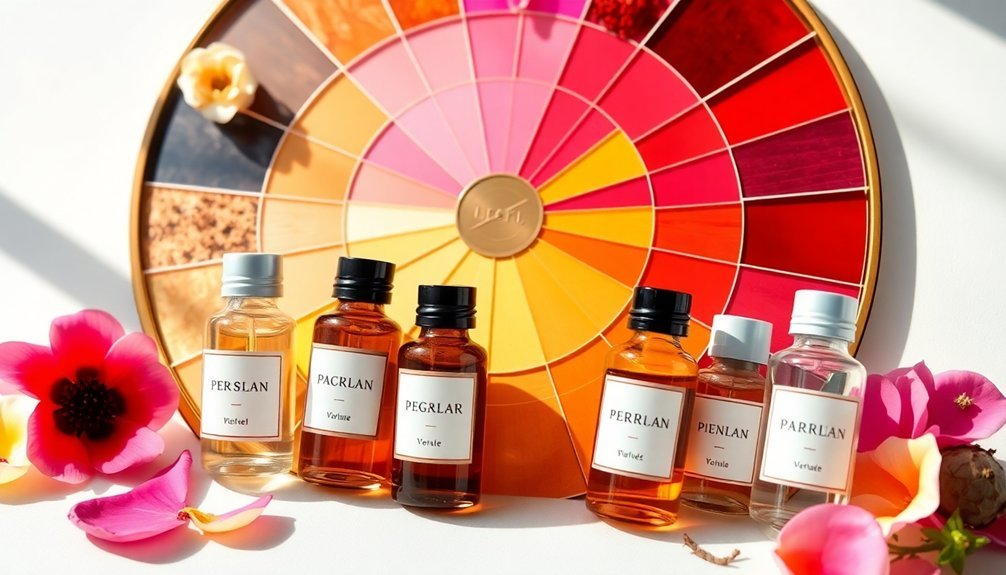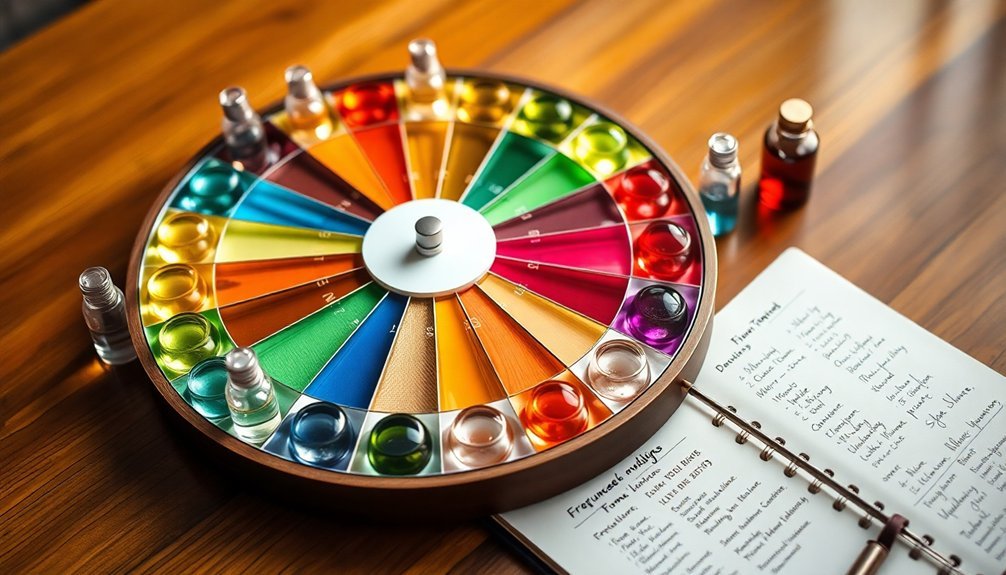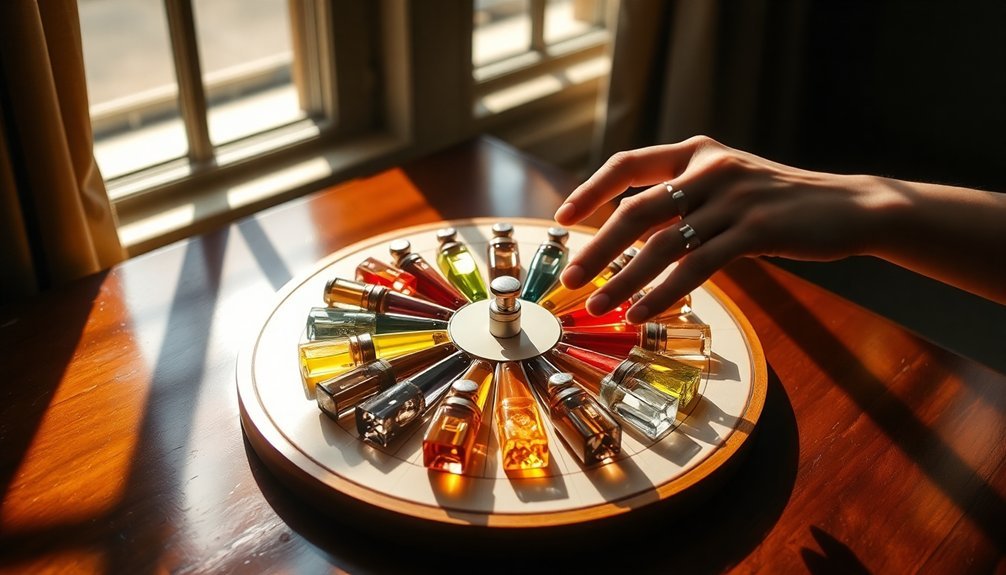When mixing fragrances using the perfume wheel, you'll want to understand the four main families: Floral, Amber, Woody, and Fresh. Start with a 3:2:1 ratio of base, middle, and top notes, ensuring your base notes make up 20-30% of the mixture. You can create seasonal blends by pairing opposite families – try mixing jasmine with bergamot for spring, or cedar with warm spices for fall. The art of perfume blending holds many more secrets to discovering your signature scent.
Understanding the Fragrance Wheel's Core Families

While exploring the world of fragrances can seem overwhelming, the perfume wheel simplifies this journey by organizing scents into four distinct families: Floral, Amber, Woody, and Fresh.
As you navigate the fragrance wheel, you'll discover that each scent family has its unique characteristics.
The Floral family embraces feminine notes like jasmine and rose, perfect for springtime wear. If you're drawn to warm, sensual aromas, the Amber family offers rich vanilla and cinnamon notes.
The Woody family combines sandalwood and cedar with subtle floral undertones, creating sophisticated, balanced fragrances. For a more invigorating experience, the Fresh family delivers citrus, oceanic, and herbal notes, commonly found in masculine scents.
Understanding these scent families helps you make informed choices when selecting your signature fragrance.
Essential Notes for Blending Perfume Recipes
To master perfume blending, you'll need to grasp the interplay between top notes, which create your fragrance's first impression, and base notes that anchor the entire composition.
While base notes form the foundation of your blend and typically represent 10-20% of the mixture, they're essential for achieving the longevity and depth that makes your scent memorable.
You can create a balanced fragrance by following the 3:2:1 ratio of base, middle, and top notes, while documenting your combinations to refine your future creations.
Top Note Blending Basics
When crafting your own signature scent, mastering top note blending serves as the foundation for a successful perfume.
You'll want to focus on fresh, light aromas that create an immediate, inviting impression when someone first experiences your fragrance composition.
Select citrus elements like lemon or bergamot, aromatic herbs such as lavender or mint, and fruity scents including apple or pear.
Remember to keep your top notes at 20-30% of the total mixture to achieve the right balance. These initial scents will last about 15-30 minutes before gracefully fading into the heart notes.
Don't be afraid to experiment with different top note combinations.
You'll discover unique blends that complement your heart and base notes, creating a harmonious fragrance that evolves beautifully over time.
Base Notes Matter Most
Base notes form the critical foundation of your perfume, anchoring the entire fragrance composition and determining how long it will last on your skin. Making up 20-30% of your perfume's structure, these deep, rich elements emerge after other notes fade, often lingering for hours or even days.
When selecting Essential Oils for your base note blend, focus on classic ingredients like sandalwood, cedar, vanilla, amber, patchouli, and musk.
You'll want to carefully balance these powerful scents with your heart and top notes to create a harmonious fragrance profile. Since base notes greatly influence your perfume's character and staying power, take extra care in choosing and measuring these foundational elements.
The success of your final fragrance largely depends on how well you incorporate these lasting components into your recipe.
Achieving Perfect Scent Balance
Creating a perfectly balanced perfume requires mastering the delicate interplay between top, heart, and base notes in precise proportions.
You'll want to follow the proven 20-50-30 ratio, where top notes comprise 20%, heart notes 50%, and base notes 30% of your blend.
To achieve the perfect scent balance, follow these essential steps:
- Start with lighter top notes first, gradually building your fragrance's foundation.
- Layer in your heart notes carefully, as they'll form half of your scent's character.
- Finish with base notes to add depth and staying power to your creation.
Remember to let your blended perfume rest for several days to a month.
During this time, keep detailed notes of your experiments – this documentation will prove invaluable as you refine your fragrance-making skills.
Creating Balanced Scent Combinations
You'll find that opposite notes on the perfume wheel often create the most compelling combinations, such as pairing fresh citrus with deep vanilla or bright florals with earthy woods.
When crafting your seasonal blends, match lighter, airy scents like bergamot and jasmine for spring and summer, while reserving richer combinations of amber and spice for fall and winter.
Your unique signature scent can emerge from experimenting with these contrasting elements, always keeping the classic 30-50-20 ratio of top, heart, and base notes in mind.
Opposite Notes Blend Well
While perfume creation might seem like a quest for similar scents, the most enchanting fragrances often emerge from combining opposing notes.
When you blend contrasting elements, like fresh citrus with warm amber or delicate florals with robust woods, you'll create a dynamic and balanced fragrance that captures attention.
The fragrance wheel reveals surprising combinations that blend well together:
- Fresh aquatic notes + rich oriental base notes = mysterious depth
- Light citrus top notes + warm amber undertones = sophisticated balance
- Soft floral heart notes + spicy wood accents = elegant complexity
You'll discover that experimenting with opposite notes isn't just about creating contrast – it's about crafting a complete sensory journey that tells your unique story through scent.
Trust your instincts and let these unexpected pairings guide your fragrance exploration.
Seasonal Fragrance Pairing Tips
Just as nature shifts through distinct seasons, your fragrance choices should evolve to match the changing atmosphere around you. These seasonal fragrance pairing tips help you create perfectly balanced combinations throughout the year.
| Season | Primary Notes | Pairing Suggestions |
|---|---|---|
| Spring | Floral scent | Blend jasmine with bergamot |
| Summer | Fresh citrus | Mix with light vanilla |
| Fall | Woody cedar | Layer with warm spices |
You'll achieve the most harmonious results by combining opposite fragrance families. Try pairing fresh citrus with warm amber in spring, or soft florals with fruits in summer. When autumn arrives, experiment with woody bases enhanced by spicy notes like cinnamon. Remember that successful seasonal layering isn't just about following rules—it's about creating unique combinations that reflect your style while complementing the weather.
Seasonal Fragrance Mixing Techniques

Creating seasonal fragrances requires a thoughtful approach to mixing scents that reflect nature's changing moods throughout the year.
Your seasonal fragrance mixing techniques should align with the natural shifts in temperature and atmosphere. You'll want to select lighter, fresher notes for spring and summer, while embracing richer, warmer scents for fall and winter months.
When working with different fragrance families, remember these essential steps:
- Begin with a seasonal base note that anchors your blend (amber for winter, citrus for summer)
- Layer complementary heart notes that reflect the season's character
- Allow your mixed fragrances to rest for several days, letting the notes harmonize naturally
Don't forget to experiment with seasonal ingredients – try oceanic notes in summer blends or spicy cinnamon in autumn creations for authentic seasonal appeal.
Advanced Layering Methods Using the Wheel
Understanding advanced layering methods requires mastering the fragrance wheel's intricate relationships between scent families. You'll achieve the best results by starting with lighter notes and building toward deeper scents while maintaining harmony between families.
| Base Note | Complementary Layer |
|---|---|
| Woody | Fresh Citrus |
| Floral | Amber |
| Fresh | Oriental |
| Citrus | Soft Floral |
| Amber | Fruity Floral |
When layering scents, start with a dominant base from one family, then add complementary notes from opposing sections of the fragrance wheel. You'll create depth by pairing fresh citrus top notes with floral hearts and warm amber bases. For enhanced complexity, try combining two fragrances from the same family while introducing subtle contrasts through subfamilies. Remember to apply lighter scents first, allowing each layer to contribute to your unique fragrance story.
Signature Blend Development Strategies

To create your signature blend, start by selecting complementary notes from your preferred scent family on the perfume wheel, such as pairing rose with jasmine for a sophisticated floral combination.
You'll discover the most harmonious combinations by methodically testing different ratios of your chosen fragrances, remembering to maintain the classic 20% essential oil proportion.
Enhance your personal scent by experimenting with layering techniques, where you can apply lighter notes first and gradually build up to deeper base notes that match your body chemistry.
Combining Complementary Scent Notes
When developing your signature fragrance blend, mastering the art of combining complementary scent notes becomes crucial for achieving a balanced and memorable perfume.
Use the fragrance wheel as your guide to identify harmonious combinations, like pairing floral notes with woody or fresh essential oil components.
Follow these key steps for successful scent blending:
- Start with a strong base note like sandalwood, then layer with a heart note such as jasmine, and finish with a fresh top note of bergamot.
- Combine amber notes with florals to create rich, luxurious depth.
- Document your mixing ratios and techniques to maintain consistency in future blends.
Remember to layer your scents from lightest to strongest, allowing each note to shine without overpowering the others.
This methodical approach guarantees your fragrance maintains harmony throughout its development.
Testing Personal Fragrance Layers
Building upon your knowledge of complementary scents, the process of developing your signature blend requires systematic testing of fragrance layers on your skin. Your body chemistry plays an essential role in how perfume notes interact, making personal testing necessary for creating your unique fragrance combination.
| Testing Phase | Key Action |
|---|---|
| Initial Layer | Apply base fragrance to pulse points |
| Second Layer | Wait 5 minutes, add heart notes |
| Third Layer | Add top notes after 10 minutes |
| Final Review | Document results in scent journal |
Keep track of your experiments in a detailed fragrance journal, noting which combinations work best with your chemistry. Let your blended scents rest for several days to achieve ideal harmony. This aging process allows the perfume notes to fully develop and reveals whether your signature blend achieves the desired balance.
Natural Versus Synthetic Note Pairings
Modern perfumery thrives on the artful combination of natural and synthetic notes, creating fragrances that capture both authenticity and innovation.
You'll find that natural notes, derived from plant sources, work harmoniously with synthetic notes to achieve complex and lasting scent profiles.
When exploring fragrance combinations, consider these essential pairings:
- Lavender's natural essence combined with synthetic vanillin creates a warm, sweet depth that's perfect for evening wear.
- Fresh bergamot oil enhanced by synthetic ethyl maltol delivers a bright, fruity personality.
- Spice-forward scents that blend natural extracts with synthetic compounds to capture elusive aromatic profiles.
Perfume Wheel Recipe Proportions

Creating your own perfume starts with understanding the essential proportions that make up a balanced fragrance.
When crafting a 10ml Eau de Parfum, you'll need to follow specific perfume wheel recipe proportions: combine 20% essential oils with 70% alcohol and optionally 10% distilled water.
For your essential oil mixture, use 40 drops total, distributed as follows: 20 drops of base notes for lasting power, 10 drops of heart notes for the core scent, and 10 drops of top notes for the initial impression.
You can adjust these ratios within the four main fragrance families – Floral, Amber, Woody, and Fresh – to create your signature scent.
Don't be afraid to experiment with different combinations while maintaining these basic proportions to achieve your desired fragrance profile.
Custom Fragrance Formula Templates
To develop a personalized fragrance blend, you'll need a reliable formula template that serves as your foundation. Custom fragrance formula templates typically follow a balanced ratio where notes are often distributed as 30% top, 50% middle, and 20% base notes. This classic proportion guarantees your scent evolves beautifully over time.
When crafting your signature scent, follow these essential steps:
- Choose your desired fragrance strength (Eau de Parfum contains 15-20% essential oils)
- Document each oil's drop count for future replication
- Use a printable chart to identify compatible note combinations
You'll find that working with a template simplifies the creative process while maintaining professional standards.
Keep track of your combinations using a systematic approach, allowing you to refine and adjust your formulas for the perfect custom blend.
Harmonizing Opposing Scent Categories

While opposing scent categories might seem incompatible at first glance, they often produce the most intriguing and sophisticated fragrances.
You'll find that harmonizing opposing scent categories, like Floral with Woody or Amber with Fresh, can create exceptional depth in your perfume compositions.
To achieve balance, start with a dominant note and gradually introduce its opposite in smaller quantities. For instance, you can pair Soft Floral elements with Dry Woods to create a complex blend that'll complement each other nicely.
The key is finding the right ratio – let one category enhance rather than overwhelm the other.
Don't be afraid to experiment with contrasting subfamilies. You might discover that combining the freshness of florals with woodsy warmth or tempering sweet amber notes with zesty accents creates uniquely appealing signatures.
Frequently Asked Questions
What Is the 30/50/20 Rule for Perfume?
You'll create balanced perfumes by following the 30/50/20 rule: use 30% top notes for initial scent, 50% middle notes for core character, and 20% base notes for lasting depth and foundation.
What Fragrance Blends Well Together?
You'll find great combinations by pairing florals with woody notes, citrus with amber, soft florals with fruity notes, earthy woods with spicy orientals, and oceanic scents with herbal fragrances for balanced, harmonious blends.
How to Know What Scents Go Together?
You'll find complementary scents by using the fragrance wheel. Start with opposite pairs like floral and woody notes, test small combinations, and trust your nose. Document successful blends to build your scent-matching expertise.
What Is the Ratio of Fragrance Oil to Perfumers Alcohol?
You'll want to use a 20:70 ratio of fragrance oil to perfumer's alcohol. For a 10ml bottle, that's about 40 drops of oils to 140 drops of alcohol, creating a standard Eau de Parfum.
In Summary
You've now mastered the perfume wheel's essential elements for creating custom fragrances. By understanding note combinations, proportions, and seasonal blending techniques, you'll confidently mix unique scents that reflect your style. Whether you're working with natural or synthetic ingredients, remember to balance opposing categories and follow the wheel's guidance. Keep experimenting with different formulas – your signature scent awaits in the perfect blend.





Leave a Reply